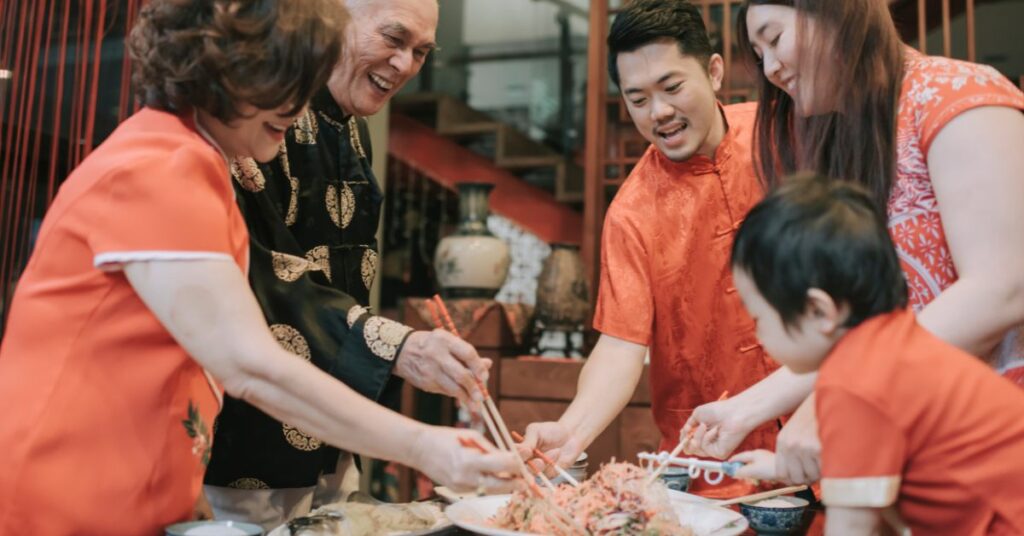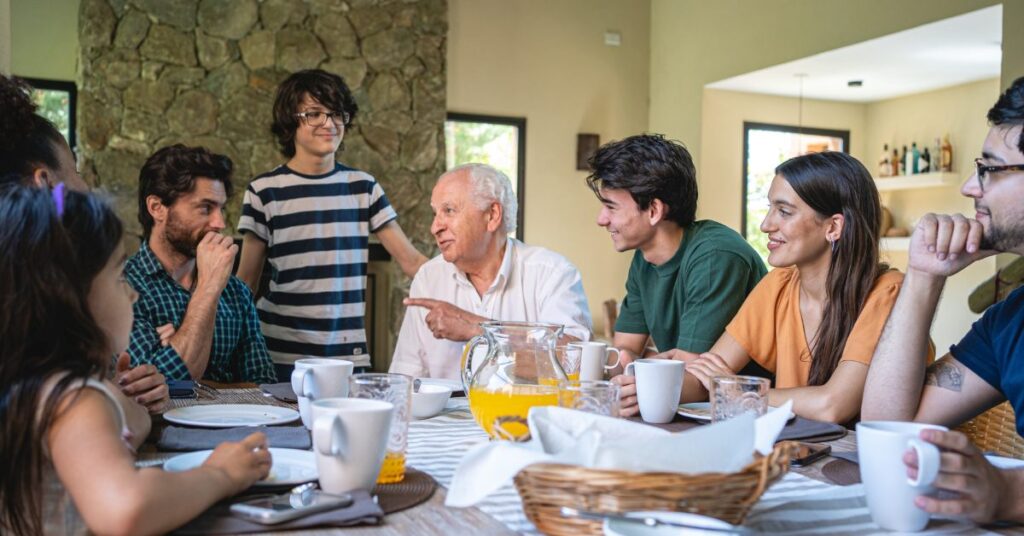Table of Contents
Introduction
In the fast-paced rhythm of contemporary life, the significance of family bonding cannot be overstated. As the cornerstone of our emotional foundation, strong family connections provide a sense of belonging, support, and resilience. This introductory section sets the stage for exploring the vital role family bonding plays in our lives.
- The Importance of Family Bonding – Family bonding is the bedrock upon which healthy relationships are built. It goes beyond mere proximity, encapsulating the emotional ties that bind family members together. These bonds contribute to the overall well-being of individuals, creating a network of support that weathers the storms of life. From childhood to adulthood, the impact of strong family connections resonates in our emotional intelligence, coping mechanisms, and interpersonal relationships.
- Challenges in Modern Society – Despite the undeniable benefits, modern society poses unique challenges to family bonding. The relentless pace of work, technological distractions, and external pressures can strain the delicate threads that weave families together. Understanding these challenges is crucial in developing strategies to overcome them and nurturing lasting connections.
- Setting the Stage for Stronger Connections – Creating an environment conducive to strong family bonds requires intention and effort. Setting the stage involves acknowledging the importance of these connections, identifying potential obstacles, and actively engaging in activities that promote unity. By doing so, families can navigate the complexities of contemporary life while reinforcing the ties that bind them together.
Understanding Family Dynamics
To cultivate strong family bonding, it’s crucial to delve into the dynamics that shape familial relationships. This section explores the diverse types of families, the influence of family structure on bonding, and common challenges encountered in family dynamics.
Types of Families
- Nuclear Families – Defined by parents and their children living together, nuclear families form the fundamental unit of society. Understanding the dynamics within nuclear families is essential for building a foundation for strong family bonding.
- Extended Families – In contrast to nuclear families, extended families encompass a broader network, often including grandparents, aunts, uncles, and cousins. Navigating the complexities of extended family dynamics adds layers to the concept of family bonding.
- Blended Families – With the prevalence of remarriages, blended families bring together individuals from previous relationships. Balancing the needs and relationships within blended families requires unique considerations for fostering unity.
The Impact of Family Structure on Bonding – The structure of a family unit significantly influences the nature of the bonds formed within it. Acknowledging and understanding these influences is paramount for fostering a harmonious environment.
- Nuclear Families – Intimate settings that allow for concentrated attention on each family member. Potential challenges in maintaining individual connections due to smaller family size.
- Extended Families – Rich in support networks and shared responsibilities. Balancing diverse personalities and generational gaps.
- Blended Families – Navigating complex relationships arising from previous commitments. Building a sense of unity and inclusivity among step-siblings.
Common Challenges in Family Dynamics – Understanding potential hurdles within family dynamics is essential for proactively addressing them. Identifying and overcoming these challenges lays the groundwork for fostering strong bonds.
- Communication Gaps – Differences in communication styles and preferences. Bridging the gap between generations in the digital age.
- Generational Differences – Varied perspectives and values across different age groups. Strategies for fostering understanding and appreciation.
- Conflicting Interests – Balancing individual pursuits within the family unit. Techniques for finding common ground and shared activities.
Benefits of Strong Family Bonding
Understanding the multitude of benefits that strong family bonds bring is pivotal for appreciating the depth and significance of these connections. This section explores the emotional, mental, and interpersonal advantages that arise from fostering robust family ties.

Emotional Support
- Creating a Safe Heaven – Strong family bonds establish a safe and nurturing environment where individuals feel secure and supported.
- Navigating Life’s Challenges – Emotional support within families helps individuals cope with life’s inevitable ups and downs.
- Fostering Open Communication – A foundation of trust allows family members to share their feelings without fear of judgment.
Mental Well-being
- Enhanced Emotional Resilience – Strong family bonds contribute to emotional resilience, aiding in coping with stress and adversity.
- Reduced Mental Health Risks – Supportive family environments are linked to lower rates of anxiety and depression.
- Creating a Sense of Belonging – A connected family unit reduces feelings of isolation, positively impacting mental health.
Improved Communication Skills
- Active Listening Techniques – Engaging in active listening within the family enhances overall communication.
- Encouraging Expressiveness – Open dialogue fosters an environment where family members feel comfortable expressing their thoughts and emotions.
- Resolving Conflicts Constructively – Strong family bonds provide a framework for resolving conflicts through effective communication.
Building Resilience
- Learning from Shared Experiences – Facing challenges together strengthens family bonds and builds resilience as a unit.
- Teaching Adaptability – Exposure to varying perspectives within the family encourages adaptability and flexibility.
- Weathering Life’s Storms – Resilient family bonds act as a support system during difficult times, promoting a sense of collective strength.
Activities for Family Bonding
Engaging in shared activities is a powerful way to strengthen family bonds, create lasting memories, and foster a sense of togetherness. This section explores a variety of outdoor, indoor, and altruistic activities that families can enjoy together.

Outdoor Adventures
- Hiking and Nature Walks – Explore local trails, parks, or nature reserves as a family. Hiking promotes physical activity and allows for meaningful conversations amidst the beauty of the outdoors.
- Camping Trips – Disconnect from the hustle of daily life by embarking on a camping adventure. Setting up tents, cooking over a fire, and stargazing create shared experiences that deepen family connections.
- Family Sports Events – Whether it’s a friendly soccer match or a day at the local park, engaging in sports together fosters teamwork and healthy competition within the family.
Indoor Bonding Activities
- Game Nights – Board games, card games, or video games – the choice is yours. Game nights provide a fun and interactive way to bond while stimulating friendly competition and laughter.
- Cooking Together – Transform the kitchen into a collaborative space. Cooking family meals not only creates delicious memories but also teaches valuable life skills.
- Movie Nights – Choose a theme, take turns picking movies, or create a cozy movie marathon. Snuggle up with blankets and popcorn for a relaxing night in as a family.
Volunteering as a Family
- Community Service Projects – Get involved in local initiatives that make a positive impact. Whether it’s cleaning up a park, participating in neighborhood clean-ups, or supporting local charities, contributing as a family strengthens bonds and instills a sense of community.
- Charity Events – Join charity walks, runs, or other fundraising events as a family. Supporting a cause together not only makes a difference but also provides a shared sense of purpose.
Nurturing Communication For Family Bonding
Effective communication is the lifeblood of strong family bonds. This section focuses on fostering open and honest dialogues, honing active listening techniques, and implementing regular family meetings and check-ins to deepen understanding and connection within the family.

Open and Honest Dialogues
- Creating a Safe Space – Establish an environment where family members feel comfortable expressing themselves without fear of judgment. Encouraging openness builds trust and strengthens emotional connections.
- Addressing Difficult Topics – Equip family members with the skills to navigate challenging conversations. Tackling difficult subjects with empathy and respect fosters understanding.
- Sharing Personal Experiences – Encourage the sharing of personal stories and experiences. This helps family members relate to each other on a deeper level, building empathy and connection.
Active Listening Techniques
- Eliminating Distractions – Foster an atmosphere of active listening by minimizing distractions during family conversations. This could involve putting away electronic devices or finding a quiet space to talk.
- Reflective Responses – Teach family members to respond reflectively, summarizing and validating each other’s perspectives. This ensures that everyone feels heard and understood.
- Empathy Building – Promote the development of empathy within the family. Encourage family members to consider and understand each other’s feelings and viewpoints.
Family Meetings and Check-Ins
- Regular Family Meetings – Schedule periodic family meetings to discuss both the positive and challenging aspects of family life. This formalizes communication channels and provides a platform for everyone to voice their thoughts.
- Setting Agenda Items – Allow each family member to contribute to the meeting agenda. This ensures that everyone’s concerns and interests are acknowledged and addressed.
- Check-Ins on Individual Well-being – Implement regular check-ins on each family member’s well-being. This can be a simple “How was your day?” or a more in-depth discussion, depending on family preferences.
Technology and Family Bonding
In an era dominated by technology, understanding how to navigate its role in family life is essential. This section explores the importance of balancing screen time, utilizing technology for family connections, and implementing digital detox strategies for a harmonious family environment.

Balancing Screen Time
- Setting Screen Time Limits – Establish clear guidelines for screen time, especially for children. Striking a balance ensures that family members engage in face-to-face interactions and other bonding activities.
- Quality over Quantity – Emphasize the quality of screen time interactions. Encourage meaningful conversations and shared activities, rather than passive screen consumption.
- Modeling Healthy Habits – Parents and guardians play a crucial role in modeling healthy screen time habits. By demonstrating a balanced approach, they set the tone for the entire family.
Utilizing Technology for Family Connections
- Virtual Family Gatherings – Leverage video calls and online platforms to connect with extended family members, especially if geographical distances pose a challenge to in-person gatherings.
- Digital Scrapbooks and Memory Sharing – Create digital scrapbooks or shared albums to document family memories. This collaborative approach fosters a sense of togetherness, even when physically apart.
- Online Games and Challenges – Engage in multiplayer online games or family challenges. This not only provides entertainment but also encourages friendly competition and collaboration.
Digital Detox Strategies
- Designated Tech-Free Times – Implement specific times during the day or week when technology is put aside. This could be during meals, family activities, or designated “tech-free hours.”
- Outdoor and Unplugged Activities – Plan outdoor activities that naturally discourage the use of technology, such as hiking, camping, or sports. This promotes physical activity and in-person interaction.
- Educating on Digital Wellness – Foster an understanding of digital wellness within the family. Educate members about the importance of balancing screen time for mental and physical well-being.
Celebrating Traditions Are Important For Family Bonding
Traditions are the fabric that weaves the tapestry of family bonds. This section explores the importance of existing family traditions, the creative process of establishing new ones, and the joyous celebration of milestones together.

Importance of Family Traditions
- Creating a Sense of Continuity – Family traditions provide a sense of continuity and stability, anchoring family members in a shared history and identity.
- Building Stronger Connections – Participating in traditions fosters a shared experience, creating opportunities for bonding and understanding among family members.
- Passing Down Values – Traditions offer a platform to pass down family values, cultural practices, and cherished beliefs from one generation to the next.
Creating New Traditions
- Identifying Shared Interests – Explore the interests and passions of family members. Building traditions around shared hobbies or activities ensures everyone’s involvement and enjoyment.
- Making it Personal – Tailor new traditions to reflect the unique dynamics and personalities within the family. Personalized traditions create a deeper sense of connection.
- Incorporating Modern Elements – Embrace modern influences and preferences when establishing new traditions. This ensures relevance and excitement for all family members.
Celebrating Milestones Together
- Acknowledging Achievements – Celebrate individual and collective achievements within the family. Whether it’s academic success, personal milestones, or professional accomplishments, recognizing and celebrating achievements fosters a positive environment.
- Creating Rituals for Milestones – Develop rituals or ceremonies to mark significant life events. These can range from birthdays and graduations to anniversaries, creating lasting memories and strengthening familial bonds.
- Encouraging Reflection – Use milestone celebrations as an opportunity for family reflection. Discussing goals, aspirations, and lessons learned reinforces the support system within the family.
Overcoming Obstacles to Bonding
Despite the desire to strengthen family bonds, certain obstacles can hinder the process. This section explores practical strategies for overcoming common challenges such as busy schedules, generational gaps, and resolving conflicts within the family.
Busy Schedules
- Prioritizing Family Time – Make a conscious effort to prioritize family time amid busy schedules. Designate specific days or hours dedicated to family activities, ensuring a consistent and meaningful connection.
- Syncing Calendars – Implement a shared family calendar to synchronize schedules. This allows for better coordination of activities and ensures that everyone is on the same page.
- Quality over Quantity – Recognize that it’s not always about the quantity of time spent together but the quality. Maximize meaningful interactions during the time available.
Generational Gaps
- Encouraging Intergenerational Activities – Plan activities that bridge generational gaps. Whether it’s sharing hobbies, teaching skills, or engaging in mutual interests, fostering connections across generations strengthens family bonds.
- Facilitating Open Dialogue – Create an environment where different generations feel comfortable expressing their perspectives. Encouraging open dialogue fosters mutual understanding and appreciation.
- Celebrating Diversity – Embrace and celebrate the diversity of experiences within the family. Recognize the value each generation brings to the family tapestry.
Resolving Family Conflicts
- Promoting Active Listening – Encourage family members to actively listen to one another during conflicts. This helps in understanding different viewpoints and working towards resolution.
- Establishing Conflict Resolution Guidelines – Develop guidelines for resolving conflicts within the family. This may include designated discussion times or agreed-upon methods for constructive communication.
- Seeking Professional Assistance – If conflicts persist, consider seeking the assistance of a family therapist or counselor. Professional guidance can provide valuable insights and tools for resolving deeper issues.
Incorporating Education into Bonding
Education provides a unique avenue for family bonding, fostering curiosity, and creating shared learning experiences. This section explores ways to integrate education into family activities, incorporating learning as a cohesive element within the family unit.

Learning Together as a Family
- Family Reading Time – Dedicate time for family reading sessions. This could involve exploring books together, sharing stories, or discussing individual reading choices.
- Educational Games and Quizzes – Engage in educational games and quizzes as a family. This not only stimulates intellectual curiosity but also adds an element of fun to the learning process.
- Joint Learning Projects – Embark on joint learning projects where family members collaborate on a topic of interest. This could range from DIY science experiments to exploring a new language together.
Educational Outings
- Museum and Science Center Visits – Plan visits to museums, science centers, and educational institutions. These outings provide an immersive learning experience while creating lasting memories.
- Historical Site Explorations – Explore historical sites and landmarks together. Understanding and appreciating history as a family fosters a shared sense of cultural awareness.
- Nature Walks and Botanical Gardens – Incorporate educational elements into outdoor activities. Nature walks and visits to botanical gardens offer opportunities to learn about the environment and biodiversity.
Building a Culture of Curiosity
- Encouraging Questions – Foster a culture of curiosity by encouraging questions and discussions within the family. Create an environment where curiosity is celebrated.
- Exploring New Hobbies Together – Discover and explore new hobbies as a family. This could include learning a musical instrument, taking up painting, or trying out a new sport.
- Attending Educational Events – Attend educational events such as lectures, workshops, or seminars together. Exposure to diverse topics stimulates intellectual curiosity and provides opportunities for shared learning.
Frequently Asked Questions (FAQs)
Navigating the terrain of family bonding can raise numerous questions. This section addresses common queries and provides practical insights for fostering strong family connections.
How do I initiate family bonding activities?
Initiating family bonding activities requires intention and creativity. Start with –
Communication – Discuss the importance of family bonding and express your desire to spend quality time together.
Identify Interests – Discover shared interests and plan activities around them.
Start Small – Begin with simple activities and gradually expand to more elaborate plans.
What if family members have conflicting interests?
Conflicting interests are common, but they can be navigated –
Find Common Ground – Identify activities that appeal to everyone, even if they have different interests.
Rotate Choices – Take turns choosing activities, ensuring each family member gets a chance to engage in something they enjoy.
Encourage Compromise – Teach the importance of compromise and flexibility in creating a harmonious family environment.
Can virtual activities contribute to family bonding?
Virtual activities can strengthen family bonds –
Video Calls – Schedule regular video calls to stay connected, share updates, and participate in virtual family gatherings.
Online Games – Engage in multiplayer online games or virtual challenges to foster a sense of togetherness.
Digital Scrapbooking – Collaborate on digital scrapbooks, sharing memories and experiences virtually.
How do you maintain family bonds with grown-up children?
Maintaining family bonds with grown-up children requires adaptability –
Open Communication – Keep communication channels open, allowing grown-up children to share their lives and experiences.
Respect Independence – Acknowledge and respect their independence while finding ways to connect on a meaningful level.
Plan Adult-Friendly Activities – Organize activities that cater to the interests of adults, ensuring engagement and enjoyment.
What if there are geographical barriers to family gatherings?
Geographical barriers can be challenging, but there are ways to overcome them –
Virtual Gatherings – Embrace video calls for virtual family gatherings during special occasions or holidays.
Plan Destination Meet-ups – Schedule periodic destination meet-ups to bridge geographical gaps and create lasting memories.
Utilize Technology – Leverage technology to share experiences, photos, and updates, fostering a sense of connection despite physical distances.
Creating a Family Bonding Plan
Building and maintaining strong family bonds requires planning and adaptability. This section provides a guide for creating a family bonding plan, emphasizing realistic goal-setting, regular scheduling of bonding time, and adapting to changing family dynamics.
Setting Realistic Goals
- Identify Priorities – Determine the key areas you want to focus on in terms of family bonding. This could include communication, shared activities, or celebrating traditions.
- Define Objectives – Set specific, measurable, and achievable objectives. Whether it’s spending more quality time together or initiating a new family tradition, clarity in goals is essential.
- Consider Individual Needs – Recognize the individual needs of each family member when setting goals. Tailor the plan to accommodate diverse interests and preferences.
Scheduling Regular Bonding Time
- Establish Consistent Times – Choose specific days or times during the week dedicated to family bonding. Consistency creates a routine and helps family members anticipate and plan for these moments.
- Quality Over Quantity – Focus on the quality of bonding time rather than the duration. Meaningful interactions in shorter periods can be more impactful than extended but less engaging activities.
- Rotate Activities – Keep things dynamic by rotating through different bonding activities. This ensures variety and accommodates the diverse interests of family members.
Adapting to Changing Family Dynamics
- Regular Check-Ins – Schedule periodic family check-ins to discuss how the bonding plan is working. This provides an opportunity to make adjustments based on changing dynamics or individual needs.
- Flexibility in Planning – Be open to adjusting the bonding plan as needed. Life is dynamic, and flexibility allows the family to adapt to evolving circumstances.
- Include Family Input – Encourage input from all family members regarding the bonding plan. This inclusivity ensures that everyone feels a sense of ownership and commitment.
The Role of Parenting in Family Bonding
Parenting plays a pivotal role in shaping the dynamics of family bonds. This section explores the multifaceted aspects of parenting that contribute to fostering strong and meaningful connections within the family unit.

Leading by Example
- Demonstrating Communication – Model effective communication by openly expressing thoughts and emotions. Demonstrating openness encourages family members to communicate freely.
- Prioritizing Family Time – Showcase the importance of family by prioritizing dedicated family time. Leading by example reinforces the value of spending quality moments together.
- Exhibiting Empathy – Display empathy towards family members. Understanding and acknowledging their feelings sets the stage for a compassionate family environment.
Balancing Authority and Friendship
- Establishing Clear Boundaries – Define clear boundaries while maintaining an approachable demeanor. This ensures a balance between authority and creating a comfortable space for open dialogue.
- Engaging in Shared Activities – Participate in shared activities to foster a sense of camaraderie. Balancing authority with friendship involves creating enjoyable experiences together.
- Encouraging Independence – Promote independence among family members while being a supportive figure. Balancing these aspects cultivates mutual respect and understanding.
Teaching Empathy and Understanding
- Empathy as a Core Value – Emphasize empathy as a foundational family value. Teach the importance of understanding and sharing the emotions of others.
- Encouraging Perspective-Taking – Encourage family members to consider different perspectives. This fosters a culture of understanding and acceptance within the family.
- Addressing Conflict Positively – Teach constructive conflict resolution. By addressing conflicts positively, family members learn to navigate disagreements while maintaining strong bonds.
Exploring Cultural Connections
Cultural connections within the family weave a rich tapestry of shared experiences, values, and traditions. This section explores the significance of embracing cultural diversity, learning and celebrating family heritage, and fostering connections across generations.

Embracing Cultural Diversity within the Family
- Acknowledging Individual Identities – Recognize and celebrate the diverse cultural backgrounds within the family. Embrace individual identities and encourage an appreciation for differences.
- Culinary Explorations – Explore and enjoy the diverse cuisines representative of each family member’s cultural background. Cooking and sharing traditional meals become a delightful way to connect.
- Festivals and Celebrations – Participate in the festivals and celebrations of different cultures within the family. This involvement fosters understanding and creates shared memories.
Learning and Celebrating Family Heritage
- Documenting Family History – Document the family’s history and heritage. This can involve creating a family tree, recording oral histories, and preserving artifacts that hold cultural significance.
- Tradition Revival – Revive and celebrate traditional family customs. Whether it’s a particular holiday celebration, a unique ceremony, or specific rituals, these practices contribute to a sense of continuity.
- Cultural Storytelling – Share stories from the family’s cultural heritage. This storytelling tradition passes down values, anecdotes, and lessons from one generation to the next.
Connecting Across Generations
- Inter-generational Activities – Plan activities that involve multiple generations. This could include crafts, storytelling sessions, or collaborative projects that bridge generational gaps.
- Learning from Elders – Encourage the younger members of the family to learn from the experiences and wisdom of elders. This intergenerational exchange enhances familial bonds and imparts valuable lessons.
- Preserving Traditions – Actively involve the older generation in preserving and passing down cultural traditions. Their guidance ensures the continuity of practices that hold familial and cultural significance.
Traveling as a Family
Traveling as a family is a transformative experience that goes beyond exploration. This section delves into the impact of travel on family bonds, provides tips for stress-free family travel, and emphasizes the importance of documenting and reflecting on travel experiences.

The Impact of Travel on Family Bonds
- Shared Adventures – Travel creates shared adventures and memories that become a cornerstone of family bonds. Experiencing new places and cultures together builds a unique connection.
- Navigating Challenges – Overcoming challenges during travel fosters teamwork and problem-solving skills within the family. These shared challenges contribute to a sense of unity.
- Quality Time in New Environments – Travel allows for quality time in new environments. Away from the routine of daily life, family members have the opportunity to connect on a deeper level.
Tips for Stress-Free Family Travel
- Planning and Communication – Plan travel itineraries in advance, and communicate plans effectively with all family members. Clarity reduces stress and ensures everyone is on the same page.
- Flexibility in Itineraries – Embrace flexibility in itineraries. Leave room for spontaneity and adjustments to accommodate the interests and needs of all family members.
- Pack Thoughtfully – Pack strategically, considering the diverse needs of family members. Include essentials, entertainment, and comfort items to make the journey smoother.
Documenting and Reflecting on Travel Experiences
- Keeping a Travel Journal – Encourage family members to keep travel journals. Documenting experiences, thoughts, and feelings creates a lasting record of the journey.
- Capturing Memories – Use photography or videos to capture moments during travel. Creating a visual diary enhances the ability to reminisce about shared experiences.
- Post-Trip Reflections – Reflect as a family after the trip. Discuss highlights, challenges, and what each member gained from the experience. This reflection deepens the impact of the journey.
The Power of Gratitude in Family Relationships
Gratitude is a powerful force that can transform family dynamics and strengthen bonds. This section explores the significance of expressing gratitude regularly, creating a gratitude ritual, and fostering positivity within the family.

Expressing Gratitude Regularly
- Verbal Appreciation – Cultivate a habit of expressing verbal appreciation regularly. Simple words of thanks and acknowledgment go a long way in reinforcing positive feelings within the family.
- Written Notes or Letters – Encourage family members to write notes or letters expressing gratitude to each other. These tangible expressions serve as lasting reminders of the love and appreciation shared within the family.
- Acknowledging Small Acts – Train family members to acknowledge and express gratitude for small acts of kindness or consideration. Recognizing these everyday gestures fosters a culture of appreciation.
Creating a Gratitude Ritual
- Daily Gratitude Sharing – Introduce a daily ritual where family members share one thing they are grateful for. This practice cultivates a positive mindset and sets the tone for the day.
- Gratitude Jar – Create a gratitude jar where family members can deposit notes expressing gratitude. Periodically, the family can read and reflect on these notes together.
- Gratitude Circle – Establish a gratitude circle during family gatherings. Each member takes a turn expressing gratitude for something specific, creating a shared moment of positivity.
Fostering Positivity within the Family
- Positive Affirmations – Integrate positive affirmations into daily family routines. Affirming each other’s strengths and qualities contributes to a more positive family atmosphere.
- Celebrating Achievements – Celebrate individual and collective achievements with enthusiasm. Acknowledging accomplishments reinforces a sense of pride and positivity within the family.
- Constructive Feedback with Gratitude – Provide constructive feedback within the family context, coupled with expressions of gratitude. This approach encourages growth and improvement in a positive environment.
Reinforcing Sibling Bonds
Siblings share a unique and lasting connection that contributes significantly to the family dynamic. This section explores the reinforcement of sibling bonds through engaging in activities and games, navigating conflicts, and building lifelong friendships within the family.
Sibling Activities and Games
- Outdoor Adventures – Plan outdoor activities that encourage sibling bonding, such as hiking, biking, or sports. These shared adventures create lasting memories.
- Creative Collaborations – Engage siblings in creative endeavors. Whether it’s painting, crafting, or cooking together, collaborative projects strengthen their bond.
- Family Game Nights – Establish regular family game nights. Board games, card games, or video games provide a fun platform for siblings to interact and enjoy each other’s company.
Navigating Sibling Conflicts
- Open Communication – Foster open communication between siblings. Encourage them to express their feelings and perspectives when conflicts arise.
- Conflict Resolution Skills – Teach and model effective conflict resolution skills. Siblings can learn to understand each other’s viewpoints and find common ground.
- Promoting Empathy – Cultivate empathy within sibling relationships. Understanding each other’s emotions contributes to a supportive and harmonious connection.
Building Lifelong Friendships within the Family
- Shared Interests – Identify and nurture shared interests between siblings. Whether it’s a hobby, sport, or intellectual pursuit, shared passions strengthen their connection.
- Supportive Atmosphere – Create a supportive family atmosphere where siblings feel encouraged to pursue their individual goals and dreams. This support fosters a sense of camaraderie.
- Celebrating Milestones Together – Celebrate individual and collective achievements. By acknowledging each other’s successes, siblings build a foundation for lifelong support and friendship.
Balancing Independence and Togetherness
Maintaining a healthy balance between individual independence and family togetherness is essential for fostering a harmonious family environment. This section explores strategies for encouraging individual growth, finding the middle ground, and respecting each other’s space.
Encouraging Individual Growth
- Supporting Personal Goals – Encourage family members to pursue personal goals and interests. Supporting individual growth contributes to a well-rounded family dynamic.
- Embracing Diversity of Passions – Acknowledge and celebrate the diversity of passions within the family. Each member’s unique pursuits contribute to the richness of the family tapestry.
- Providing Resources for Development – Provide resources and opportunities for personal development. Whether it’s educational pursuits, hobbies, or career aspirations, fostering individual growth enhances the overall family experience.
Finding the Middle Ground
- Scheduling Family Time – Establish regular family time but be flexible in scheduling. Finding a middle ground ensures that family members can participate while accommodating individual commitments.
- Compromising on Activities – Encourage compromise when selecting family activities. Finding activities that cater to different interests ensures everyone can enjoy the experience.
- Shared Decision-Making – Involve family members in decision-making processes. By collaboratively deciding on family plans, everyone has a stake in the activities and feels valued.
Respecting Each Other’s Space
- Designated Personal Spaces – Allocate designated personal spaces within the home. Respecting each other’s need for personal space contributes to a sense of autonomy.
- Establishing Boundaries – Communicate and establish boundaries regarding personal time and space. Open dialogue ensures that individual needs are understood and respected.
- Encouraging Open Communication – Foster an environment of open communication. Family members should feel comfortable expressing their need for space or time alone without judgment.
Professional Guidance for Troubled Family Relationships
While proactive efforts can enhance family bonds, recognizing the signs of strained relationships and seeking professional guidance is crucial for families facing challenges. This section explores the importance of recognizing signs of strained family bonds, the potential benefits of therapy or counseling, and the overall significance of professional intervention.
Recognizing Signs of Strained Family Bonds
- Communication Breakdown – Identify a breakdown in communication patterns. If family members struggle to express themselves or if there’s constant miscommunication, it may indicate strained bonds.
- Frequent Conflicts – Take note of the increased frequency and intensity of conflicts within the family. Persistent disagreements can signal underlying issues that need attention.
- Emotional Distress – Pay attention to signs of emotional distress in family members. Withdrawal, sadness, or anxiety may indicate unresolved issues impacting the family dynamic.
Seeking Therapy or Counseling
- Family Therapy – Consider family therapy as a proactive approach to addressing familial issues. A trained therapist can facilitate open communication and guide the family toward resolution.
- Individual Counseling – Explore individual counseling for family members dealing with specific challenges. Personalized sessions can address individual concerns, contributing to overall family well-being.
- Couples Counseling – If marital issues are affecting the family, couples counseling can be beneficial. Addressing relationship challenges at the core can positively impact the entire family unit.
Importance of Professional Intervention
- Objective Perspective – Professional intervention provides an objective perspective. Therapists can assess the family dynamics without personal biases, offering insights and guidance.
- Structured Communication – Therapists facilitate structured communication. This ensures that each family member has a platform to express themselves and be heard, fostering understanding.
- Skill Building – Professional guidance equips family members with communication and conflict resolution skills. These tools contribute to a healthier family dynamic beyond the therapy sessions.
Evaluating the Success of Family Bonding Efforts
Evaluating the success of family bonding efforts is crucial in ensuring the continual growth and strength of familial connections. This section explores methods for assessing communication levels, monitoring emotional well-being, and celebrating milestones and achievements as indicators of successful family bonding.
Assessing Communication Levels
- Openness and Transparency – Evaluate the level of openness and transparency in family communication. A successful bonding effort is reflected in family members feeling comfortable expressing thoughts and emotions.
- Active Listening – Assess the practice of active listening within the family. Effective communication involves not just speaking but also truly hearing and understanding each other.
- Resolution of Conflicts – Monitor how conflicts are handled. Successful family bonding efforts are characterized by constructive conflict resolution, where conflicts lead to growth rather than division.
Monitoring Emotional Well-being
- Expressions of Joy and Positivity – Observe expressions of joy and positivity within the family. Successful bonding efforts contribute to an overall positive emotional atmosphere.
- Addressing Emotional Distress – Monitor how emotional distress is addressed. A successful family bonding approach involves acknowledging and addressing emotional challenges in a supportive environment.
- Sense of Belonging – Evaluate the family members’ sense of belonging. A successful family bonding creates an environment where each member feels valued, accepted and an integral part of the family unit.
Celebrating Milestones and Achievements
- Individual and Collective Milestones – Celebrate individual and collective milestones. Recognizing achievements, whether big or small, reinforces a sense of accomplishment and unity within the family.
- Expressing Gratitude for Efforts – Assess the expression of gratitude for family bonding efforts. Recognizing and appreciating the commitment each member puts into strengthening family bonds is vital.
- Reflecting on Growth – Reflect on the growth of family relationships over time. A successful family bonding journey involves continuous improvement and deepening connections.
Conclusion
The journey of family bonding is a dynamic and ongoing process that requires intention, effort, and adaptability. As we conclude our exploration of strategies to strengthen family bonds, we reflect on the transformative impact of these efforts, the enduring significance of strong family connections, and the encouragement to prioritize these vital relationships.
Reflecting on the Journey
- Acknowledging Progress – Take a moment to acknowledge the progress made on the family bonding journey. Reflect on the positive changes, shared experiences, and the growth of familial connections.
- Learning from Challenges – Consider challenges as opportunities for growth. Reflect on how challenges were navigated, lessons learned, and resilience developed within the family unit.
- Adapting and Evolving – Recognize the importance of adaptability. The family bonding journey is not static; it evolves with the changing dynamics of family life. Embrace the need for ongoing adaptation.
The Lifelong Impact of Strong Family Bonds
- Emotional Well-being – Strong family bonds contribute significantly to emotional well-being. The support, understanding, and love within a family create a foundation for individual and collective happiness.
- Resilience in Challenges – Families with strong bonds are more resilient in the face of challenges. The sense of unity and mutual support helps family members navigate difficulties with greater strength.
- Positive Influence on Individuals – Strong family connections positively influence individual members. From childhood through adulthood, the impact of a supportive family environment lasts a lifetime.
Encouraging Others to Prioritize Family Connections
- Sharing Success Stories – Share success stories and experiences from the family bonding journey. Inspire others by highlighting the positive outcomes and the joy that comes from prioritizing family connections.
- Emphasizing the Value of Time – Emphasizing the value of time spent with loved ones. Encourage others to prioritize family moments, recognizing that these moments are the building blocks of enduring relationships.
- Promoting Open Communication – Advocate for open communication within families. Encourage dialogue, understanding, and the expression of love to fortify the bonds that tie family members together.
In conclusion, family bonding is a continuous and rewarding endeavor that shapes the foundation of our lives. As we reflect on the journey, appreciate the lifelong impact of strong family bonds, and extend encouragement to others, we recognize the enduring value of these connections in fostering happiness, resilience, and a sense of belonging. May every family find joy and strength in their unique journey of family bonding and connection.


1 thought on “Family Bonding – Strengthening Connections In 2024”